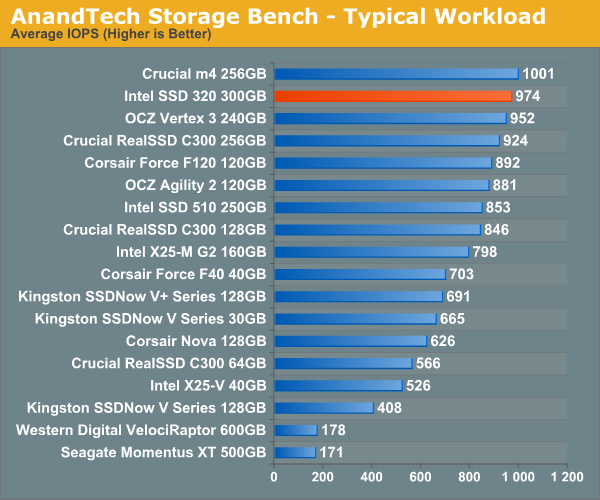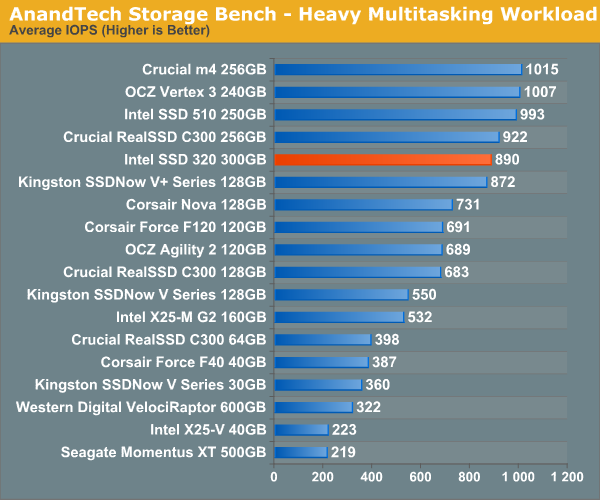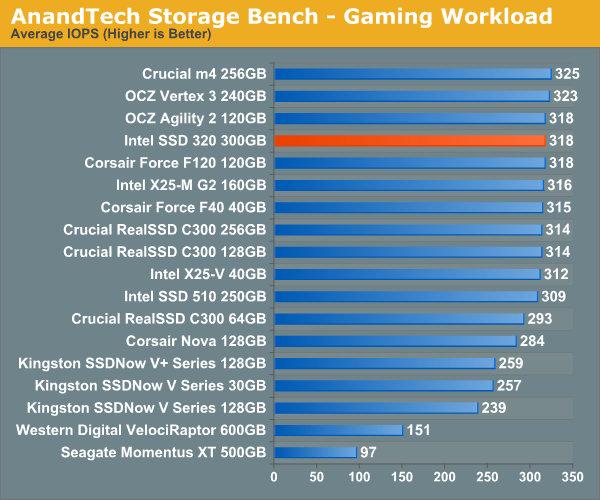The Intel SSD 320 Review: 25nm G3 is Finally Here
by Anand Lal Shimpi on March 28, 2011 11:08 AM EST- Posted in
- IT Computing
- Storage
- SSDs
- Intel
- Intel SSD 320
AnandTech Storage Bench 2010
To keep things consistent we've also included our older Storage Bench. Note that the old storage test system doesn't have a SATA 6Gbps controller, so we only have one result for the 6Gbps drives.
The first in our benchmark suite is a light/typical usage case. The Windows 7 system is loaded with Firefox, Office 2007 and Adobe Reader among other applications. With Firefox we browse web pages like Facebook, AnandTech, Digg and other sites. Outlook is also running and we use it to check emails, create and send a message with a PDF attachment. Adobe Reader is used to view some PDFs. Excel 2007 is used to create a spreadsheet, graphs and save the document. The same goes for Word 2007. We open and step through a presentation in PowerPoint 2007 received as an email attachment before saving it to the desktop. Finally we watch a bit of a Firefly episode in Windows Media Player 11.
There’s some level of multitasking going on here but it’s not unreasonable by any means. Generally the application tasks proceed linearly, with the exception of things like web browsing which may happen in between one of the other tasks.
The recording is played back on all of our drives here today. Remember that we’re isolating disk performance, all we’re doing is playing back every single disk access that happened in that ~5 minute period of usage. The light workload is composed of 37,501 reads and 20,268 writes. Over 30% of the IOs are 4KB, 11% are 16KB, 22% are 32KB and approximately 13% are 64KB in size. Less than 30% of the operations are absolutely sequential in nature. Average queue depth is 6.09 IOs.
The performance results are reported in average I/O Operations per Second (IOPS):

If we strip 6Gbps out of the equation completely, the SSD 320 does very well in our old light workload. You're looking at performance that's at the top of the pack from the mainstream offering.
If there’s a light usage case there’s bound to be a heavy one. In this test we have Microsoft Security Essentials running in the background with real time virus scanning enabled. We also perform a quick scan in the middle of the test. Firefox, Outlook, Excel, Word and Powerpoint are all used the same as they were in the light test. We add Photoshop CS4 to the mix, opening a bunch of 12MP images, editing them, then saving them as highly compressed JPGs for web publishing. Windows 7’s picture viewer is used to view a bunch of pictures on the hard drive. We use 7-zip to create and extract .7z archives. Downloading is also prominently featured in our heavy test; we download large files from the Internet during portions of the benchmark, as well as use uTorrent to grab a couple of torrents. Some of the applications in use are installed during the benchmark, Windows updates are also installed. Towards the end of the test we launch World of Warcraft, play for a few minutes, then delete the folder. This test also takes into account all of the disk accesses that happen while the OS is booting.
The benchmark is 22 minutes long and it consists of 128,895 read operations and 72,411 write operations. Roughly 44% of all IOs were sequential. Approximately 30% of all accesses were 4KB in size, 12% were 16KB in size, 14% were 32KB and 20% were 64KB. Average queue depth was 3.59.

Crank up the workload and the 320 falls a bit behind the rest of the competitors. Last year's heavy multitasking workload is nothing compared to what we introduced earlier this year, so it's still pretty light by comparison but it's clear for normal usage the 320's 3Gbps performance is quite good.
The gaming workload is made up of 75,206 read operations and only 4,592 write operations. Only 20% of the accesses are 4KB in size, nearly 40% are 64KB and 20% are 32KB. A whopping 69% of the IOs are sequential, meaning this is predominantly a sequential read benchmark. The average queue depth is 7.76 IOs.











194 Comments
View All Comments
etamin - Monday, March 28, 2011 - link
This is probably a noob question for many of you but can someone explain to me why having a 6gbps controller/interface would increase performance if the drive itself maxes out at 240MB/s sequential read speed (128KB)? isn't 3gbps equal to 384MB/s? If the Intel 320 cannot saturate the SATA 3gbps bandwidth, what good would a 6gpbs bandwidth do for it? similarly, why do a lot of disk drives today have 6gbps interfaces when they can barely saturate 1/3 of a 3gbps interface? Thanks.nonzenze - Monday, March 28, 2011 - link
Because the controller can burst higher if data is handy in a cache.etamin - Tuesday, March 29, 2011 - link
I see. Is there a measure for burst speeds and I'm assuming this only applies to read operations?UNHchabo - Monday, March 28, 2011 - link
SATA uses 8b/10b encoding in all current revisions. This means that the theoretical limit for SATA 3Gb/s is 300MB/s.etamin - Tuesday, March 29, 2011 - link
very interesting, I'll be sure to keep that possibility in mind before converting other standards next time.Chloiber - Tuesday, March 29, 2011 - link
As you can clearly see with SATA3 SSDs running at SATA2, it's way lower.etamin - Thursday, March 31, 2011 - link
yes, that is obvious. I asked because I want to understand the architectural reason behind it.Nentor - Monday, March 28, 2011 - link
They are all so close to each other an unscrupulous HD manufacturer could use them to show there is barely any difference between a SSD and a HD.Why add keep adding them to the SSD articles?
etamin - Monday, March 28, 2011 - link
I think having HDDs in these articles sets a good baseline for those of us who don't already own ssds. Personally I'd actually like to see more hdds like 5400rpm notebook drives since many of these SSDs will be going into notebooks.wvh - Monday, March 28, 2011 - link
What exactly do I need to have encryption support? I've never noticed a SATA password option in my BIOS. Do most laptops support this?Lackluster as the performance seems to be, encryption support and increased reliability – while not sexy – are important, too. If not the enthusiast market, the corporate world might have more interest in such drives.